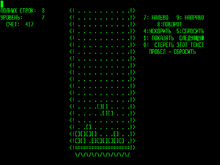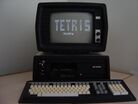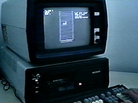Tetris (Electronika 60)
| Tetris | |
|---|---|
 | |
| Developer(s) | Alexey Pajitnov |
| Platform(s) | Electronika 60 |
| Release |
|
| Gameplay info | |
| Next pieces | 1 |
| Playfield size | 10 × 20 |
| Hold piece | No |
| Hard drop | Yes |
| Rotation system | Original Rotation System |
Tetris (Russian: Тетрис) was created by Alexey Pajitnov using the Pascal programming language on an Electronika 60, an unauthorized Soviet clone of the Digital Equipment Corporation PDP-11 computer. The game originally featured monochrome graphics. In its first version, the blocks in the tetrominos were represented by pairs of delete/rubout characters (character code 177). On Soviet clone machines like the Electronika 60, this character code rendered as a rectangle, but on an actual PDP-11, the same code displayed as empty space.
A later revision replaced the delete/rubout characters with square brackets to represent the blocks.
In 2003, to promote the movie Tetris (2023), a web version was released called Tetris E60.
Included with Tetris Forever is a rebuilt version of the game.
Gameplay
Pressing "1" on the keyboard toggles a preview of the next piece.
Scoring
- Points are awarded for each tetromino successfully dropped into place.
- At level 0, the potential point score for each tetromino starts at 19, and decreases by 1 every time the tetromino descends a row due to gravity. As can be seen, an I tetromino falling freely from the top of the playfield to the bottom will descend 19 rows and score 0; it is never possible to score less than 0.
- Playing at higher levels awards an additional 3 x Level points per tetromino. (e.g., +0 points for Level 0, +3 points for Level 1, +6 points for Level 2, etc.)
- Playing with the preview disabled awards an additional 5 points per tetromino.
- 3 digits are provided for score display; when 999 is exceeded, the counter rolls back to 0 and a tally of symbols appear in order to keep track of thousands.
Bugs
It is sometimes possible to manipulate a tetromino after performing a hard drop, even though it is supposed to be locking. Doing so will leave a trail of blocks behind, which, although visible to the player, are not recognized by the game as actually being there. This can lead to a variety of unusual scenarios, for example, visibly complete rows will not clear, and tetrominos can be dropped through the stack.
Trivia
- In the BBC documentary Tetris: From Russia with Love, a DVK-3 computer is shown displaying a TETRIS logo screen (assumed to be the "1985" edition, based on dating in Tetris Forever).
- In Tetris The Grand Master 3 Terror-Instinct's Shirase mode, pieces turn into brackets at level 1000 to 1300.
- Tetris The Grand Master 4 Absolute Eye contains two mino skins being the brackets, unlocked from playing KONOHA mode. It is also similarly forced in NORMAL 3.1 at level 1000 until the end of the mode.
- In the PC and PS2 versions of Tetris Worlds, reaching rank 11 for all the Story mode games will unlock Hadar, a basic clone of this version.
- In 2023, Tetris E60, an official web game was released to promote the movie Tetris, emulating the look of the original.
- Tetris Effect has a theme that references this version.
- Tetris Forever features a recreation of the game. It offers two versions that it refers to as a "1984" edition (featuring a title/logo in Russian), and a "1985" edition (featuring the title "TETRIS" in large block letters composed of various other characters).

